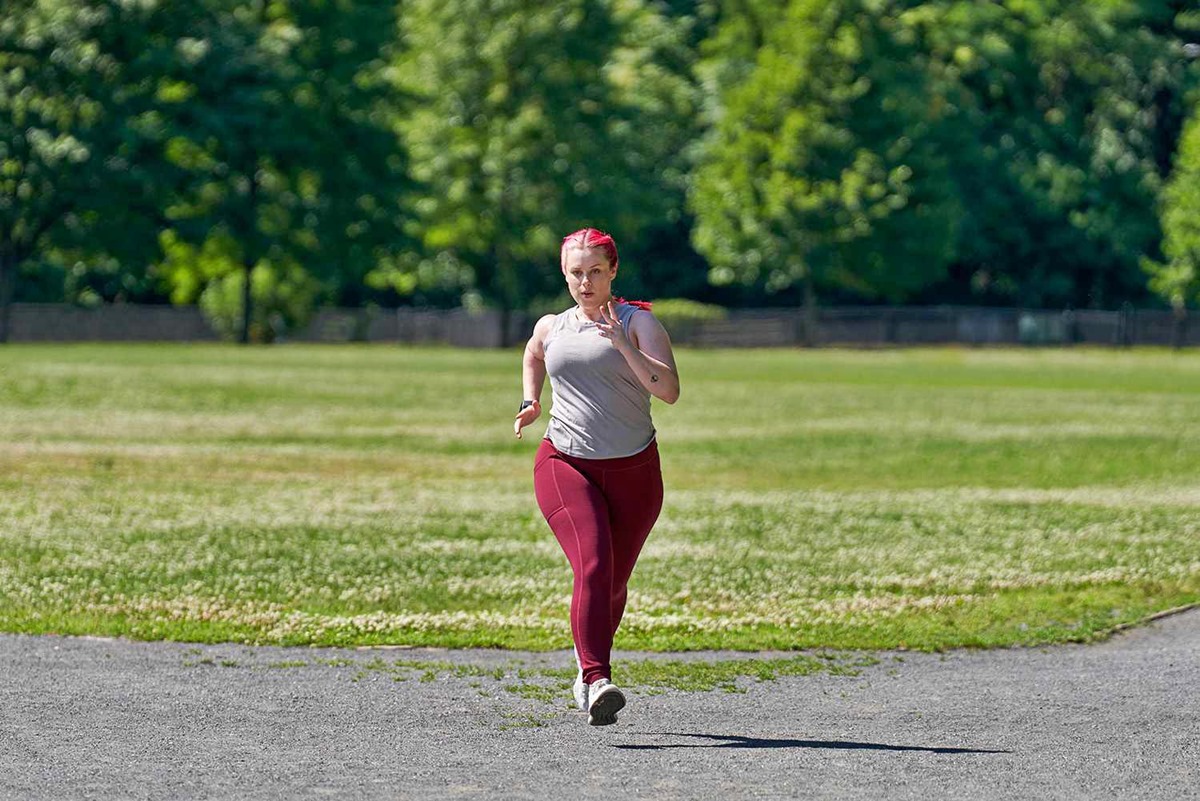

Featured
How To Build Up Hiking Endurance
Modified: January 2, 2024
Get featured hiking tips and techniques to build up your endurance on the trails. Discover expert advice on how to take your hiking abilities to the next level and conquer any challenge you face.
Introduction
Are you an avid hiker looking to take your adventures to the next level? Or maybe you’re just starting out on your hiking journey and want to build up your endurance? Regardless of your experience level, building up hiking endurance is vital to tackling longer, more challenging trails while enjoying the beauty of nature.
Hiking endurance refers to your ability to sustain physical activity over extended periods of time. It’s not about sprinting through the trails; rather, it’s about having the stamina and strength to hike for hours, or even days, without feeling exhausted.
Building up hiking endurance is a gradual process that requires a combination of physical training, proper nutrition, mental preparation, and adequate rest and recovery. By following a well-rounded approach, you can enhance your stamina, improve your cardiovascular fitness, and ultimately conquer those lengthy and demanding hikes.
In this article, we’ll explore various strategies and tips on how to build up hiking endurance. We’ll delve into the importance of setting realistic goals, establishing a solid fitness foundation, incorporating cardiovascular and strength training, planning proper nutrition, staying hydrated, preparing mentally, and allowing for sufficient rest and recovery.
So, if you’re ready to embark on a hiking journey that pushes your limits and allows you to explore breathtaking landscapes, let’s dive into the world of building up hiking endurance!
Understanding Hiking Endurance
Before we dive into the strategies for building up hiking endurance, it’s important to understand what hiking endurance is and why it’s crucial for a successful hiking experience.
Hiking endurance is the ability to sustain physical activity while hiking for extended periods of time. It encompasses both cardiovascular endurance and muscular endurance. Cardiovascular endurance is the ability of your heart, lungs, and blood vessels to deliver oxygen to your muscles efficiently, while muscular endurance refers to the ability of your muscles to perform repeated contractions without fatigue.
Improving your hiking endurance has several benefits. Firstly, it allows you to explore longer and more challenging trails, opening up a whole new world of adventure. Additionally, increased endurance enhances your overall fitness level, improves heart health, boosts metabolism, and promotes weight management.
When it comes to hiking, endurance is essential because trails can vary in difficulty and duration. Whether you’re planning a day hike or a multi-day trek, having sufficient endurance ensures that you’re able to enjoy the journey without feeling excessively tired or overwhelmed.
It’s important to note that building hiking endurance requires consistent effort and progressive training. It’s not something that can be achieved overnight, but with dedication and the right approach, you can gradually increase your stamina and conquer longer and more challenging hikes.
One key element to understand is that hiking endurance is individual and subjective. Everyone starts at a different fitness level and progresses at their own pace. Therefore, it’s crucial to set realistic goals and focus on your own progress rather than comparing yourself to others.
Now that we’ve established the importance of hiking endurance and its benefits, let’s move on to the next section where we’ll discuss setting realistic goals to guide your training journey.
Setting Realistic Goals
When it comes to building up hiking endurance, setting realistic goals is key. Goals provide direction, motivation, and a sense of accomplishment as you progress on your journey. However, it’s important to set goals that are attainable and tailored to your current fitness level.
First, assess your current hiking abilities and fitness level. Consider the length and difficulty of the trails you typically hike, how much time you spend hiking each week, and your overall physical fitness. This self-assessment will give you a baseline from which to set your goals.
When setting goals, it’s important to be specific and measurable. Instead of a generic goal like “improve endurance,” consider setting a goal such as “increase hiking duration by 30 minutes within the next month.” This allows you to track your progress and stay motivated as you work towards achieving that specific goal.
Additionally, it’s important to set both short-term and long-term goals. Short-term goals can help you stay motivated and focused on small victories along the way, while long-term goals provide a bigger picture and something to strive for in the future.
It’s also crucial to consider the timeframe for achieving your goals. Be realistic about how much time and effort you can commit to your training. Setting unrealistic or overly ambitious goals can lead to frustration and burnout.
Another important aspect of goal-setting is making them challenging yet achievable. Pushing yourself outside of your comfort zone is necessary for growth, but setting goals that are too difficult can result in discouragement. Gradual progression is key, so start with manageable goals and gradually increase the intensity and duration as you build up your endurance.
Remember, goals are meant to inspire and motivate you, not overwhelm you. Celebrate your achievements along the way, no matter how small they may seem, as they are all stepping stones towards your ultimate hiking endurance goals.
Now that you have a clear understanding of setting realistic goals, let’s move on to the next section where we’ll discuss how to build a solid fitness foundation to support your hiking endurance training.
Building a Solid Fitness Foundation
Before embarking on any hiking endurance training, it’s important to have a solid fitness foundation. Building a strong foundation will not only make your training more effective, but it will also help prevent injuries and improve overall performance on the trail.
One key component of building a solid fitness foundation is developing a regular exercise routine. Incorporating a mix of cardiovascular exercises, strength training, and flexibility work will help improve your overall fitness and prepare your body for the demands of hiking.
Cardiovascular exercises such as running, cycling, swimming, or using the elliptical machine can help improve your heart and lung function, allowing you to tackle those long hikes with ease. Aim for at least 150 minutes of moderate-intensity aerobic exercise, or 75 minutes of vigorous-intensity exercise, per week.
Strength training is equally important in building a solid fitness foundation. Focus on exercises that target your legs, core, and upper body to improve muscular endurance and stability. Squats, lunges, deadlifts, planks, and push-ups are great exercises to include in your strength training routine.
In addition to cardiovascular and strength training, don’t forget about flexibility. Stretching exercises, yoga, or Pilates can help improve your range of motion, prevent muscle imbalances, and reduce the risk of injury while hiking. Incorporate stretching into your routine at least a few times per week.
Consistency is key when building a fitness foundation. Aim for at least three to five days of exercise per week, and gradually increase the duration and intensity of your workouts. Listen to your body and give yourself time to recover between sessions.
Lastly, prioritize proper posture and alignment during your workouts. This will help improve your overall body mechanics and prevent strains or injuries. Engage your core, maintain a tall posture, and pay attention to your form during exercises.
By building a solid fitness foundation, you’ll be well-equipped to take on the challenges of hiking endurance training. Remember to approach your training journey gradually and stay committed to your routine. With time and dedication, you’ll be ready to tackle those lengthy and demanding hikes.
Now that we’ve discussed the importance of building a solid fitness foundation, let’s move on to the next section where we’ll explore incorporating cardiovascular training to enhance your hiking endurance.
Incorporating Cardiovascular Training
Cardiovascular training is paramount when it comes to building up hiking endurance. It helps improve your heart and lung capacity, allowing you to hike for longer periods without feeling fatigued. Incorporating specific cardiovascular exercises into your training routine will enhance your overall endurance and stamina on the trail.
The key to effective cardiovascular training is to engage in activities that elevate your heart rate and challenge your cardiovascular system. There are various options to choose from, and it’s important to find activities that you enjoy and that align with your fitness level.
Running or jogging outdoors or on a treadmill is a great cardiovascular exercise that closely mimics the movement patterns of hiking. Start with a pace and distance that is comfortable for you, and gradually increase both as your endurance improves. Interval training, which involves alternating between periods of high-intensity running or sprinting and low-intensity recovery, can be particularly beneficial for boosting cardiovascular fitness.
Cycling is another excellent cardiovascular exercise option. Whether you prefer outdoor biking or stationary cycling at the gym, it provides a low-impact workout that targets the muscles used in hiking while also building cardiovascular endurance. Adjust the resistance and speed to challenge yourself and gradually increase the duration of your rides.
Swimming is a full-body workout that is gentle on the joints, making it an ideal cardiovascular exercise for individuals who may have joint limitations or injuries. It engages all major muscle groups, improves cardiovascular fitness, and enhances lung capacity. Incorporate different swimming strokes and vary your intensity to make your workouts more challenging.
Hiking itself is an excellent form of cardiovascular training. It allows you to directly simulate the demands of your intended hikes, helps to strengthen specific muscles used in hiking, and prepares your body for the terrain and altitude changes you may encounter. Start with shorter hikes and gradually increase the distance and difficulty over time.
Regardless of the cardiovascular exercise you choose, aim for at least 150 minutes of moderate-intensity aerobic activity or 75 minutes of vigorous-intensity activity per week. Spread your workouts throughout the week to allow for proper recovery.
Remember to listen to your body and gradually increase the duration and intensity of your cardiovascular training. Push yourself to challenge your limits, but also recognize the importance of rest and recovery in order to avoid overtraining or injuries.
In the next section, we’ll explore the role of strength training in building hiking endurance and how it can enhance your overall performance on the trail.
Strength Training for Hiking Endurance
Strength training is a crucial component of building up hiking endurance. It helps improve muscular endurance, stability, and overall strength, enabling you to handle the demands of long hikes and challenging terrains.
When it comes to strength training for hiking endurance, it’s important to focus on exercises that target the specific muscle groups used in hiking. These include the legs, core, and upper body.
Begin with exercises that focus on your legs, as they play a significant role in hiking. Squats, lunges, step-ups, and calf raises are excellent exercises to strengthen the muscles in your thighs, hips, and calves. These exercises not only improve your overall leg strength but also enhance your stability and balance on uneven terrain.
Core exercises are equally important, as they provide stability and support for your entire body while hiking. Planks, side planks, Russian twists, and mountain climbers are effective exercises that target your core muscles, including the abdomen, lower back, and obliques. A strong core not only helps you maintain proper posture and balance but also reduces the risk of lower back pain during long hikes.
Don’t neglect your upper body. While hiking primarily engages the lower body, having upper body strength can be beneficial for stability, balance, and overcoming obstacles on the trail. Push-ups, pull-ups, rows, and shoulder presses can help strengthen your arms, shoulders, and back, allowing you to carry a backpack more comfortably and maneuver through challenging terrains.
When incorporating strength training into your routine, aim for two to three sessions per week. Allow for proper rest and recovery between sessions to avoid muscle fatigue and overtraining. If you’re new to strength training, consider working with a qualified trainer to learn proper form and technique.
As you progress, gradually increase the weight, repetitions, or difficulty of the exercises to continue challenging your muscles. Mix up your routine by incorporating variations of exercises or using equipment such as dumbbells, resistance bands, or bodyweight exercises.
Remember that as a hiker, your goal is to develop muscular endurance rather than bulk. Focus on using lighter weights with higher repetitions to build endurance and stamina rather than solely focusing on increasing your maximum strength.
By incorporating strength training into your hiking endurance training, you’ll not only improve your overall performance on the trail but also reduce the risk of injuries and fatigue. Combine it with cardiovascular training and proper nutrition for a well-rounded approach to enhancing your hiking endurance.
In the next section, we’ll discuss the importance of planning proper nutrition to fuel your body during long hikes.
Planning Proper Nutrition
Proper nutrition plays a crucial role in building up hiking endurance. Fueling your body with the right nutrients before, during, and after your hikes can help enhance your performance, maintain energy levels, and support muscle recovery.
Prior to your hike, focus on consuming a balanced meal that includes a good mix of carbohydrates, protein, and healthy fats. Carbohydrates provide the primary source of energy for your muscles, so opt for complex carbohydrates like whole grains, fruits, and vegetables. Protein helps repair and build muscle tissue, so include lean sources such as poultry, fish, legumes, or tofu. Healthy fats, found in nuts, seeds, avocados, and olive oil, provide sustained energy and support brain function.
During your hike, it’s essential to stay properly fueled and hydrated. Pack lightweight, nutrient-dense snacks that are easy to consume on the trail. Trail mix, energy bars, dried fruits, and jerky are all excellent options. Aim to consume carbohydrates to maintain energy levels, and include some protein to support muscle function and repair. Stay hydrated by drinking water regularly, and consider electrolyte-replenishing options such as sports drinks or electrolyte tablets, especially during longer hikes or hot weather.
Post-hike nutrition is just as important. Consuming a combination of carbohydrates and protein within 30 minutes to an hour after your hike can aid in muscle recovery and replenish glycogen stores. A balanced meal or snack that includes lean protein, whole grains, and fruits or vegetables is ideal. Additionally, don’t forget to continue hydrating to replace any fluids lost during your hike.
It’s important to listen to your body and adjust your food intake based on the intensity and duration of your hikes. If you have a multi-day hike planned, consider packing lightweight and nutrient-dense meals or meal replacement bars to ensure you’re meeting your nutritional needs without carrying unnecessary weight.
While planning your nutrition, also consider any dietary restrictions or allergies you may have. Tailor your meals and snacks to accommodate these needs and choose options that provide the necessary nutrients for your hiking endurance.
Remember, proper nutrition is not only about the food you consume during your hikes, but also about maintaining a well-balanced diet overall. Eating a variety of whole foods, staying hydrated, and fueling your body properly will contribute to your overall hiking endurance and well-being.
In the next section, we’ll explore the importance of staying hydrated during long hikes and how it can impact your endurance.
Hydrating for Long Hikes
Staying properly hydrated is essential for maintaining optimal hiking endurance. Hydration plays a crucial role in regulating body temperature, lubricating joints, and delivering nutrients to your muscles. During long hikes, the combination of physical exertion and exposure to the elements can lead to significant fluid loss, making it essential to prioritize hydration.
Before your hike, start off well-hydrated by consuming fluids throughout the day. Aim to drink at least 16-20 ounces of water or other non-caffeinated beverages a few hours before your hike to ensure you’re adequately hydrated. Urine color can be a good indicator of hydration status – aim for a pale, straw-like color.
During your hike, make it a priority to drink water regularly. The exact amount of water needed will vary depending on factors such as intensity of the hike, weather conditions, and your own individual sweat rate. As a general guideline, aim to drink 0.5-1 liter of water per hour of hiking.
Carrying a hydration bladder or water bottles with you will make it easier to access water and encourage frequent sips. Additionally, consider incorporating electrolyte-replenishing options, such as sports drinks or electrolyte tablets, to replace essential minerals lost through sweat.
Be mindful of signs of dehydration, such as increased thirst, dark-colored urine, dry mouth, dizziness, or fatigue. If you experience any of these symptoms, it’s important to take a break in a shaded area and rehydrate promptly.
If you’re hiking in a location where water sources are available, such as streams or lakes, and it is safe to do so, consider purifying water using a water filter or purification tablets. This will allow you to replenish your water supply along the way.
After your hike, continue to hydrate to replace any fluids lost during the hike. Aim to consume water or other hydrating beverages within the hour following your hike, and monitor your urine color to ensure sufficient hydration.
It’s important to note that individual hydration needs may vary, so it’s crucial to pay attention to your body and adjust your fluid intake accordingly. Proper hydration is key to maintaining energy levels, preventing fatigue, and optimizing your hiking performance.
In the final section, we’ll discuss the importance of mental preparation and mindset when it comes to building hiking endurance.
Mental Preparation
In addition to physical training and proper nutrition, mental preparation is crucial for building hiking endurance. Hiking can be physically demanding and mentally challenging, especially during long and strenuous hikes. Having the right mindset and mental strategies can help you push through tough moments and stay motivated on the trail.
One important aspect of mental preparation is setting realistic expectations. Understand that building hiking endurance takes time and effort. There will be setbacks, difficult moments, and times when you may feel fatigued. Embrace the challenges as part of the journey and remind yourself of the progress you’ve made.
Visualization can be a powerful tool in mental preparation. Before your hike, take a few moments to visualize yourself successfully completing the hike and enjoying the beautiful scenery. Visualize yourself feeling strong, resilient, and motivated. This positive imagery can help boost confidence and create a positive mindset.
Practice mindfulness during your hikes. Be fully present in the moment, focusing on the sights, sounds, and sensations around you. When faced with difficult terrain or exhaustion, bring your attention back to your breath and take it one step at a time. Mindfulness can help you stay grounded, reduce anxiety, and enhance your overall hiking experience.
Develop a mantra or positive affirmation that resonates with you. Repeat it to yourself during challenging moments on the trail. Whether it’s a simple phrase like “I am strong and capable” or a personal mantra that inspires you, this positive self-talk can help boost your confidence and provide motivation when the going gets tough.
Connect with nature and find joy in the journey. Take the time to appreciate the natural beauty around you, listen to the sounds of the wilderness, and immerse yourself in the experience. Cultivating a sense of gratitude and awe can help shift your mindset and make the hike more enjoyable.
Surround yourself with a supportive hiking community. Join hiking groups, seek out like-minded individuals, or hike with friends who share your passion for the outdoors. Being in the company of others who understand and appreciate the challenges of building hiking endurance can be motivating and uplifting.
Lastly, be kind to yourself and practice self-compassion. Acknowledge that building hiking endurance is a journey, and it’s okay to have ups and downs along the way. Celebrate your progress and embrace the learning experiences that come with each hike.
Mental preparation is as important as physical training when it comes to building hiking endurance. By adopting a positive mindset, practicing mindfulness, and utilizing mental strategies, you can cultivate the mental resilience needed to conquer long hikes and enjoy the journey.
As we conclude this article, remember that building up hiking endurance is a gradual process that requires commitment, patience, and consistency. Utilize the strategies shared in this article, and adapt them to your own needs and preferences. With time, dedication, and a positive mindset, you’ll be well on your way to building the hiking endurance needed to tackle any trail that comes your way.
Rest and Recovery
Rest and recovery are crucial components of building hiking endurance. It’s during periods of rest that your body repairs and strengthens itself, allowing you to progress in your training and perform at your best on the trail.
When engaging in intense physical activity like hiking, it’s important to listen to your body and give it the rest it needs. Overtraining or not allowing enough time for recovery can lead to fatigue, decreased performance, and increased risk of injury.
Schedule regular rest days in your training program. These are days dedicated to complete rest or low-intensity activities that allow your body to recover and recharge. On rest days, focus on activities that promote active recovery, such as gentle stretching, yoga, or light walking.
Sleep is a critical component of rest and recovery. Aim for 7-9 hours of quality sleep per night to allow your body to heal, repair tissues, and replenish energy stores. During sleep, important hormones are released to support muscle recovery and growth.
Proper nutrition also plays a role in recovery. Ensure that you’re consuming enough calories to support your energy needs and replenish nutrients lost during your hikes. Including a mix of carbohydrates, protein, and healthy fats in your meals will aid in muscle recovery and repair.
Hydration is equally important during rest and recovery periods. Drink plenty of water throughout the day to maintain optimal hydration levels and support your body’s natural recovery processes. Avoid excessive consumption of caffeinated beverages, as they can interfere with sleep and lead to dehydration.
Engage in activities that promote relaxation and stress reduction. Stress can hinder recovery, so finding ways to unwind and relax is vital. Consider activities such as meditation, deep breathing exercises, or taking time to enjoy hobbies that help you disconnect and recharge.
Pay attention to any signs of overtraining or injury. If you’re experiencing persistent fatigue, increased soreness, decreased performance, or pain, it may be a sign that you need to rest and recover. Pushing through these signs can lead to further complications, so listen to your body and adjust your training accordingly.
Lastly, be patient with your progress. Building hiking endurance takes time, and allowing for adequate rest and recovery is part of the process. Embrace rest days as an essential part of your training program and trust that giving your body the time it needs to recuperate will ultimately improve your performance on the trail.
As you focus on building your hiking endurance, remember that rest and recovery are just as important as the physical training itself. By incorporating these strategies into your routine, you’ll optimize your training, reduce the risk of injury, and ensure that you’re able to enjoy your hiking adventures to the fullest.
With that, we’ve covered all the key aspects of building up hiking endurance. Now it’s time for you to lace up your boots, hit the trails, and embark on your own journey towards becoming a stronger and more experienced hiker. Happy hiking!
Conclusion
Building up hiking endurance is a process that requires dedication, perseverance, and a comprehensive approach. By incorporating the strategies outlined in this article, including setting realistic goals, building a solid fitness foundation, incorporating cardiovascular and strength training, planning proper nutrition, staying hydrated, preparing mentally, and allowing for sufficient rest and recovery, you can enhance your stamina, improve your cardiovascular fitness, and conquer those lengthy and challenging hikes.
Remember, building hiking endurance takes time and consistency. It’s essential to start at your own fitness level and progress gradually, listening to your body along the way. Celebrate your achievements, no matter how small, and embrace the challenges as learning opportunities.
As you embark on your journey to build up hiking endurance, remember to infuse your adventures with a sense of joy and appreciation for nature. Take the time to connect with the natural world, be mindful of your surroundings, and find moments of awe and gratitude along the way.
Now, armed with the knowledge and strategies shared in this article, it’s time to lace up your hiking boots, hit the trails, and push your limits. Every step forward is a step towards increasing your hiking endurance, exploring breathtaking landscapes, and achieving new heights in your outdoor experiences.
So, go out there, embrace the challenges, and enjoy the rewards that come with building up hiking endurance. Happy hiking!









